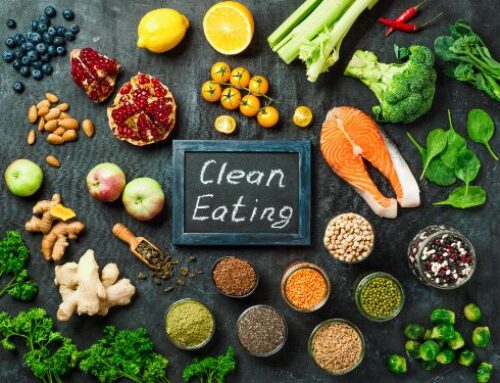If you catch yourself saying, “New year, new me,” with no solid plan on how to achieve a healthier you, try a switch to clean eating (accompanied with exercise, of course). The overtones of the clean eating movement centers around feeding your body more of what is natural and what it needs. This is a deliberate move away from processed foods and toward environmentally-friendly practices (you can add “help the environment” onto your New Year’s Resolutions, too!). Here are some reasons and ways to start clean eating and living.
Put the spotlight on ingredients, not calories
In this instance, it really is a quality over quantity issue. It doesn’t matter how low the calories are if the ingredients are chock full of unhealthy, processed sugars. This also means don’t cut foods out just because they are high in calories. For example, nuts and avocados are both high in calories, but they’re also high in fiber and protein (read more about the healthy benefits of avocados from this Heathline article). Remember, there’s more to the calorie count than what meets the eye.
Keep the processed foods on the shelf
What exactly is the deal about processed foods? The issue in a nutshell is processed foods contain practically no essential nutrients which means what you’re left with is “empty” carbs. These empty carbs pose a huge risk if you’re like the 40 to 50 million people who hold sedentary jobs with no regular activity programs and are inactive around the house. These carbs don’t just go away. Read more on processed foods in this article from Medical News Today. A good start clean, healthy eating definitely involves being aware of what you eat and keeping the processed foods out of your diet.
Build exercise into your schedule
Just as how peanut butter is to jelly, exercise is to healthy eating habits. With these 53 exercises, you don’t even have to shell out more money for a gym membership. This list of at-home exercises include simple but effective exercises such as squats, reverse lunges, extended leg pulses and burpees, just to name a few. Build a routine that you can follow at least three times a week, if not every day. The best part is with as many as 53 at-home exercises, you can create a variety of routines to mix it up and keep exercise interesting. Make exercise an intentional part of your daily routine and soon it’ll become a habit to does lead to a healthier and happier you (courtesy of our close friends, endorphins).
Cleaner body, cleaner environment
One habit that can improve your diet and the environment at the same time is cutting down on your meat consumption. Health benefits include reducing your blood pressure and risk of heart disease. Environmental benefits include a chain reaction that could reduce carbon emissions. Currently, livestock accounts for anywhere between 14.5 and 18 percent of human-induced greenhouse gas emissions worldwide, according to an article published by the New York Times. By purchasing less meat, the laws of demand and supply come into play and we have a chance of reducing the amount of livestock the meat industry feels compelled to raise, which in turn reduces the amount of carbon emissions.
Load up on more veggies
When you cut down your meat intake, you give yourself the chance to increase your vegetable intake! An increased vegetable intake may result in the decreased risk of heart disease, obesity, type 2 diabetes, certain cancers, kidney stones, bone loss, and that’s not even the end of the list. Bottom line is when you eat vegetables, you feed the body what it needs which boosts your health and immune system.
Try a variety of recipes
How can you incorporate all these practices of focusing on ingredients (and not calories), foregoing the processed foods, eating less meat and more vegetables? There are plenty of recipes you can look into (click here for a 14 days worth of recipes, here for 25 recipes, and here for more recipes than you could care to count), but at the core of it all is bringing the action home. Incorporate more home-cooked meals and meal prep to keep yourself on track. It’s when we’re running short on time that we find ourselves reaching for the ramen or granola bar (two foods pretty high on the list of processed foods to avoid). Relieve yourself from the stress of having to cook a meal after waking up late by finding a set time in your week to prepare all your meals.
There are several more ways to expand this move toward a more all-natural, healthy, environmentally friendly way of living beyond just eating and exercising. You can also evaluate your beauty products, cleaning products, and daily habits to become more aware of the products you use as well as the impact of your purchases and actions. Looking at what you put on your plate and in your body, though, is a great way to start.





Yes each and every year I say that and act on it for a while and then get off of it! I love my veggies always stick to that part, but some people actually stick with the plan and succeed! So I am saying it again this time and stick with it and always safe to be around nice clean environment keeps you more healthier and more to manage your health! So yes it was be did by me!
I have no plans for new year’s
Clean habits provide a sense of calm and peace.
Awesome. This is very helpful. SYCHRONICITY at work. When the student is ready. The Teachers will appear. And I sm 40 years old. And still getting new teachers and guidance every day. I been fighting for my life. Morgellons Desease is trying to kill me. It almost succeeded. I’m a Warrior of God. JESUS CHTIST our Lord And Saviour. My star family has kept me alive. I still have to do my part yo help myself. My LIGHT is very Strong. But it is not at its full powers yet. Due to the blockages and toxicity of my body. I been Detoxifying. Spiritually, Mentally, and Physically. From what I read so far. These recipes is extremely helpful. More Prayers being answered through thos website. So thank you. And God Bless, Nameste!!!
This is a new start of the New Year to eating healthy and becoming more stess free
stress free and doing something positive s awesome thanks for the helping hints and clean habits
A clean environment is a healthy environment couldn’t agree more.
I know for a fact that the natural way is the best way to feed our bodies. Plenty of vegetables. Get rid of the process sugar and salt. Start there. And then we can move on.
Love me some veggies!!!
Hi Yes I have been trying to eat cleaner & healthier! Less carbs, sugar ,& salt! Try to skip desserts as much as possible. Enjoy kiwi fruit , bananas & Fuji apples.! I do the Mediterranean diet & love Lentil soup. Greek food is healthy! Try it! My fave food is Japanese though!
I completely agree with eating the very best that you can organic whole foods fresh is so important to keep you at your best
I have been making a green smoothie in the mornings is the best way to start your day
I completely agree with this.
I agree with this healthy inspiration. It is ideal for my adult sons as well